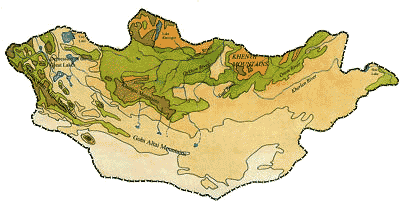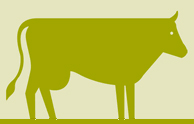
MAIN MENU
Mongolia
 Mongolia
beckons with a rare glimpse into an ancient culture and the last unspoiled
wilderness in Asia.
Mongolia
beckons with a rare glimpse into an ancient culture and the last unspoiled
wilderness in Asia.
Relatively unchanged for centuries, Mongolia has one of the last remaining
horse-based, nomadic cultures in the world.
The countryside is unscarred by industrialization or intensive agriculture and sustains some of the last remaining pristine ecosystems in Asia. In stark contrast to the congested Asian continent, only 2.4 million people reside in Mongolia. With an area approximately the size of Western Europe, Mongolia has one of the lowest population densities in the world. Mongolia has also set aside one tenth of its territory into a system of protected areas. This commitment provides habitat for plant and animal species that have all but disappeared from the rest of the continent.
Additionally, the government has pledged to increase the system of protected areas to 30% of the country, resulting in the largest national park system in the world.
Climate
Mongolia is high, cold, and dry. It has an extreme continental climate with long, cold winters and short summers, during which most precipitation falls. The country averages 257 cloudless days a year, and it is usually at the center of a region of high atmospheric pressure. Precipitation is highest in the north, which averages 20 to 35 centimeters per year, and lowest in the south, which receives 10 to 20 centimeters (see fig. 5). The extreme south is the Gobi, some regions of which receive no precipitation at all in most years. The name Gobi is a Mongol meaning desert, depression, salt marsh, or steppe, but which usually refers to a category of arid rangeland with insufficient vegetation to support marmots but with enough to support camels. Mongols distinguish gobi from desert proper, although the distinction is not always apparent to outsiders unfamiliar with the Mongolian landscape. Gobi rangelands are fragile and are easily destroyed by overgrazing, which results in expansion of the true desert, a stony waste where not even Bactrian camels can survive.

High Mountain Zone: Mongolia is a mountainous country. The Mongolian
Altai and Gobi Altai mountain ranges extend across nearly two-thirds of
the nation's breadth. In the center of the country, the Khangai mountains
divide Asia's continental watershed, lie the rugged and uninhabited Khentii
mountains.
In the far western Altai, Khuiten Peak in the Tavan Bogd mountains reaches
4653 meters, the highest point in the country. ( The lowest point, in
the Khokh Lake depression, at 532 meters, is far out on the eastern steppe.)
Climate in the high mountain zone is extreme , with high winds, extreme
cold, and a short growing season. Relatively few species are adapted to
these harsh conditions. Located above tree line, the zone is characterized
by tundra, alpine-sedge meadows, highland swamps, and lichen-covered boulder
fields.
 Taiga (Forest)
Zone: Mongolia'sThe taiga zone, which covers about 5% of Mongolia,
experiences more precipitation ( 300 to 400 mm annually ) and lower temperatures
than most of Mongolia, with cold, snowy winters and cool, rainy summers.
In Mongolia, although affected by some mining and timber developments,
the taiga remains largely undisturbed.
Taiga (Forest)
Zone: Mongolia'sThe taiga zone, which covers about 5% of Mongolia,
experiences more precipitation ( 300 to 400 mm annually ) and lower temperatures
than most of Mongolia, with cold, snowy winters and cool, rainy summers.
In Mongolia, although affected by some mining and timber developments,
the taiga remains largely undisturbed.
Mountain Forest Steppe Zone: In the mountain forest steppe zone, the species of Siberia's taiga meet those of the Central Asian steppe. Mixed coniferous forest is found on cooler, moister northern slopes, while steppe vegetation predominates on other slopes. Providing habitat for species from both the steppe and the taiga, this zone has a high degree of biological diversity. Wide river valleys separate the hilly terrain characteristic of this zone. The mountain forest steppe zone covers about 25% of Mongolia, and is one of the most heavily populated areas in Mongolia. Its pastures, wood, and water make it an important area for herders and their livestock. The zone is also the site of some densely populated urban areas.
Steppe Zone: Steppe covers nearly the entire far eastern part of Mongolia, extending west in a narrowing band just south of the Khangai and Khan Khokhii mountains all the way to the Depression of the Great Lakes. Varying from gently rolling terrain to areas as flat as a table, this " sea of grass " covers over 20% of Mongolia's land area. Mongolia's steppe lies in the eastern part of the vast plain that begins in eastern Europe and reaches t the steppes of Manchuria. The steppe zone includes a distinctive group of flora and fauna. In the central and western areas of the country, the steppe provides many of the nation's most important grazing lands for domestic livestock. Here, one of the world's largest remaining examples of an undisturbed steppe ecosystem provides a home for hundreds of thousands of Mongolian gazelle and a diverse array of migratory birds.
Desert Steppe Zone (semi desert): Desert steppe occupies a large
band, more than 20% of Mongolia's area, extending across the country between
the steppe and desert zones. This zone includes the Depression of the
Great Lakes, the Valley of the Lakes, and most of the area between the
Khangai and Altai mountain ranges, as well as the eastern Gobi area. The
zone includes many low-lying areas, soils with salt pans, and small ponds.
The climate is arid with frequent droughts and annual precipitation of
100-125 mm, and frequent strong winds and dust storms strongly influence
the areas vegetation. Many of Central Asia's endemic plant species are
found here, as are some steppe and desert species of plants and animals.
Desert Zone: These areas provide habitat for many of Mongolia's threatened
species, including the wild camel, Gobi bear, and wild ass. In particular
, Dzungarian Gobi ( the western Gobi ) has a unique composition of animals
and plants. Ancient fossils show that the Gobi was once part of a large
inland sea basin.
 Climate
is extreme. Precipitation may fall only once every two three years, and
averages less than 100 mm annually. Temperatures climb as high as 40°
C in summer, and fall as low as -40° in winter. During the spring
and fall, dangerously strong winds buffet the area with dust storms and
wind speeds up to 140 km/hour.
Climate
is extreme. Precipitation may fall only once every two three years, and
averages less than 100 mm annually. Temperatures climb as high as 40°
C in summer, and fall as low as -40° in winter. During the spring
and fall, dangerously strong winds buffet the area with dust storms and
wind speeds up to 140 km/hour.